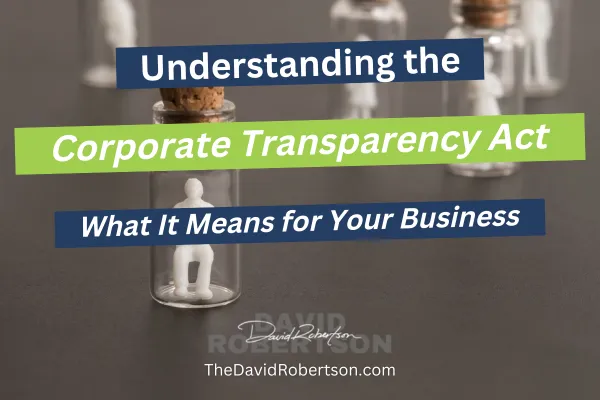I Build Companies Worth Owning and Leaders Worth Following.
I Build Companies Worth Owning and Leaders Worth Following.
A business growth ecosystem equipping Founders, Investors, and Operators with the systems, tools, capital, and support to build profitable, self-sustaining companies.

Latest
Blog Articles.

Understanding the Corporate Transparency Act (CTA) and What It Means for Your Business
Update on CTA Enforcement (Updated on December 18, 2024):
As of December 3, 2024, a nationwide preliminary injunction has temporarily blocked the enforcement of the Corporate Transparency Act (CTA) and its Beneficial Ownership Information (BOI) reporting requirements. While this halts the January 1, 2025, filing deadline, businesses should take the following steps:
Stay Informed: Monitor legal developments, as the injunction may be modified or overturned.
Evaluate Compliance Plans: Be prepared to resume compliance efforts if the injunction is lifted.
Consider Voluntary Filing: Some businesses may choose to file their BOI voluntarily while the FinCEN system is still accepting submissions.
We’ll continue to monitor this situation and provide updates as new information becomes available.
Why Transparency Matters for Businesses Today
Have you thought about how the 2024 Corporate Transparency Act (CTA) might affect your business operations? Starting in 2024, businesses across the U.S. will face new legal requirements to report detailed ownership information. While this initiative is aimed at curbing financial crimes like money laundering and terrorism financing, it also places a new administrative responsibility on businesses, especially small to medium-sized companies.
Understanding these changes now can help you avoid penalties, maintain compliance, and protect your reputation. In this guide, we’ll explore the key aspects of the CTA and how you can ensure your business is ready.
What Is the Corporate Transparency Act?
The Corporate Transparency Act was passed in 2021 as part of the National Defense Authorization Act. It introduces new rules for businesses to disclose information about their “beneficial owners” to a centralized database managed by the Financial Crimes Enforcement Network (FinCEN). This move is designed to increase corporate accountability, ensuring that businesses are not being used as vehicles for criminal activities.
While this legislation primarily targets shell companies and illicit activities, it also applies broadly to many legitimate businesses.
Key Requirements Under the Corporate Transparency Act
To comply with the CTA, businesses must meet specific reporting requirements related to beneficial ownership. Let’s break this down into three key areas.
Who Qualifies as a Beneficial Owner?
The CTA defines a beneficial owner as any individual who meets either of the following criteria:
Ownership Interest: Someone who directly or indirectly owns at least 25% of the company’s ownership interests.
Substantial Control: Someone who exercises substantial control over the company’s operations or decisions.
Understanding who qualifies as a beneficial owner within your organization is critical to meeting your reporting obligations.
What Information Must Be Reported?
Businesses are required to report detailed information about each beneficial owner, including:
Full legal name.
Date of birth.
Residential or business address.
A unique identifying number from an acceptable government-issued document, such as a passport, driver’s license, or state-issued ID.
This information will be stored securely by FinCEN and will only be accessible to authorized government agencies and financial institutions conducting due diligence.
Scope of the Law
The CTA applies to most corporations, limited liability companies (LLCs), and similar entities formed under U.S. laws. However, there are exemptions, which we’ll cover in more detail below.
Who Must Comply with the Corporate Transparency Act?
The CTA applies broadly, but there are some exceptions. It’s important to understand whether your business falls within the reporting requirements or qualifies for an exemption.
Entities Required to Report
Most small businesses, LLCs, and closely held corporations.
Newly formed entities starting on or after January 1, 2024.
Pre-existing entities formed before January 1, 2024.
Exempt Entities
Certain businesses and organizations are exempt from the CTA’s reporting requirements, including:
Publicly Traded Companies: These are already subject to SEC reporting requirements.
Large Operating Companies: Companies with more than 20 full-time employees, over $5 million in annual revenue, and a physical office in the U.S.
Financial Institutions: Banks, credit unions, and other heavily regulated entities.
Nonprofit Organizations: Charitable and religious organizations are generally exempt from reporting.
If your business does not qualify for an exemption, you will need to comply with the reporting requirements.
Timeline for Compliance
Adhering to the CTA’s deadlines is critical to avoiding penalties. The compliance timeline is as follows:
For New Entities: Businesses formed on or after January 1, 2024, must report beneficial ownership information when they register with the state.
For Pre-Existing Entities: Businesses formed before January 1, 2024, have until January 1, 2025, to file their reports.
Staying on top of these deadlines is essential to ensure compliance and avoid costly consequences.
Penalties for Non-Compliance
Failing to comply with the CTA’s requirements can result in significant penalties:
Civil Penalties: Up to $500 per day for failing to report or update information.
Criminal Penalties: Fines of up to $10,000 and imprisonment for up to two years for willfully submitting false information or failing to report.
These penalties highlight the seriousness of the law and the need for businesses to act proactively.
Steps to Ensure Compliance with the Corporate Transparency Act
Preparing your business for CTA compliance doesn’t have to be overwhelming. Here are some practical steps you can take:
Step 1: Assess Beneficial Ownership
The first step is to identify all individuals who meet the beneficial ownership criteria. Review your business’s ownership structure to ensure you have clarity on who qualifies as a beneficial owner.
Step 2: Gather Required Documentation
Collect the necessary information for each beneficial owner, including their full legal name, date of birth, address, and a copy of their government-issued ID. Verify the accuracy of this information to avoid errors in your report.
Step 3: Consult Legal and Financial Experts
Work with a legal or compliance expert to understand your obligations under the CTA. They can help you navigate complex ownership structures, determine exemptions, and ensure your business is aligned with the law.
Step 4: Establish a Compliance Process
Set up a process within your organization to maintain accurate and up-to-date ownership records. Designate a responsible individual or team to handle ongoing compliance, including updates to beneficial ownership information as required.
Step 5: Leverage Technology for Reporting
Consider using software or digital tools to streamline the collection, storage, and submission of beneficial ownership information. These tools can help reduce administrative burdens and ensure your data is secure.
How the Corporate Transparency Act Impacts Your Business
For many small to medium-sized businesses, the CTA introduces a new layer of administrative responsibility. While the additional reporting requirements may feel burdensome, they also present an opportunity to improve internal record-keeping and ensure your business aligns with regulatory standards.
Proactively preparing for the CTA can also protect your business from reputational damage, legal risks, and financial penalties. Moreover, it positions your company as a trustworthy and transparent organization in the eyes of regulators and business partners.
Looking Ahead: What to Expect
As the CTA takes effect, businesses should expect increased scrutiny around ownership transparency. It’s possible that the requirements could evolve over time, so staying informed about updates to the law will be essential.
In addition to meeting your immediate compliance obligations, consider this an opportunity to strengthen your internal governance practices. Transparency isn’t just a regulatory requirement—it’s a cornerstone of good business leadership.
Final Thoughts
The Corporate Transparency Act represents a significant shift in how businesses operate. By requiring beneficial ownership reporting, it aims to deter criminal activities and increase corporate accountability. While this adds a new compliance burden, it also reinforces the importance of trust and integrity in business operations.
Preparing early is the key to staying ahead of these changes. If you have questions about how the CTA affects your business or need guidance on creating a compliance plan, don’t hesitate to reach out. When you’re ready to file your Beneficial Ownership Information (BOI) report, visit https://www.fincen.gov/boi for more information about how to file.

Let's
Connect.
Have a question or want to connect with me?

David Robertson is a serial entrepreneur, investor, and coach passionate about Advancing the Kingdom of Christ in business.
© David Robertson | All Rights Reserved | This Site Designed by GrowthpointCRM™
Disclaimer:
All content on this website is authored by David Robertson, an experienced business consultant. The views and opinions expressed are his own and do not reflect those of any current or former employers, including International Services, Inc. (ISI) or its affiliates. Professional consulting services are currently provided exclusively through ISI or its affiliated companies. Employment statuses and affiliations are subject to change without notice.
Any investments or investment activities mentioned are conducted solely through Robertson Equities, LLC. and are not associated with or endorsed by ISI or its affiliates. ISI and its affiliates are not responsible for the content on this website or any online activities conducted by David Robertson.
David Robertson makes no representations as to the accuracy or completeness of any information on TheDavidRobertson.com or from any links found on this site. He will not be liable for any errors or omissions, nor for the availability of this information.

